Royal Lao Army
This article may need to be rewritten to comply with Wikipedia's quality standards. (May 2009) |
| Royal Lao Army | |
|---|---|
| Armée royale du Laos ກອງທັບລາດຊະອານາຈັກລາວ | |
| Size | 35,000 (at height) |
| Part of | Royal Lao Armed Forces |
| Garrison/HQ | Phone Kheng (Vientiane) |
| Nickname(s) | RLA (ARL in French) |
| Anniversaries | 1 July – RLA Day |
| Engagements | First Indochina War Laotian Civil War Vietnam War |
| Commanders | |
| Notable commanders | Sounthone Pathammavong Phoumi Nosavan Ouane Rattikone Kouprasith Abhay |
The Royal Lao Army (Lao: ກອງທັບລາດຊະອານາຈັກລາວ; French: Armée royale du Laos – ARL), also designated by its anglicized title RLA, was the land component of the Royal Lao Armed Forces (FAR), the official military of the Kingdom of Laos during the North Vietnamese invasion of Laos and the Laotian Civil War between 1960 and 1975.
History
This section needs expansion. You can help by adding to it. (November 2022) |
The ARL traced back its origins to
Meanwhile, confronted in early May 1945 with the Allied Powers' victory over Nazi Germany and sensing their own imminent defeat, the Japanese military authorities in Laos began stirring up local anti-French nationalistic sentiments. In October of that year, a group of supporters of Laotian independence led by Prince Phetsarath Ratanavongsa deposed King Sisavang Vong and announced the formation of a new government body, the Committee for Independent Laos (Lao: ຄະນະ ກຳ ມາທິການເພື່ອປະເທດລາວອິດສະຫຼະ, romanized: Khana kam mathikan pheu pathedlav idsara) or Khana Lao Issara and Lao Issara for short.[4] Taking advantage of the temporary absence of French authority in the country's main cities, the Lao Issara promptly established an armed defense force to exercise its authority with the support of Ho Chi Minh's Viet Minh Hanoi-based government in the Tonkin and the Nationalist Chinese. The Lao Issara "Army" was essentially a lightly armed militia force, provided with a mixed assortment of small-arms captured from the Japanese, looted from French colonial depots, or sold by the Chinese Nationalist Army troops who occupied northern Laos under the terms of the 1945 Potsdam Conference.
The National Laotian Army 1946–1955
In early
However, faced with the potential threat posed by the growing Viet Minh insurgency in neighbouring Vietnam, the French instituted on July 1, 1949, a separated National Laotian Army (Armée Nationale Laotiènne – ANL) of the French Union to defend Laos.[6] Its formation actually began earlier in 1947, with the creation of the Land Forces of Laos (Forces Terrestres du Laos – FTL), a gathering of several indigenous irregular auxiliary units made of ex-Lao Issara guerrillas raised early by the French to reinforce their regular CEFEO units.[7]
The process of formation of the new Laotian army started on March 23, 1950, when its first regular units were raised, consisting of light infantry battalions officered by the French. By
In July 1959, the ANL, the Laotian Navy, and the Laotian Aviation were gathered into the newly created Laotian Armed Forces (Forces Armées Laotiènnes – FAL), renamed Royal Lao Armed Forces (Forces Armées du Royaume – FAR) in September 1961.[13]
Structure
The chain of command of the Royal Lao Army was placed under the Ministry of Defense in Vientiane. The country was divided into five military regions, roughly corresponding to the areas of the country's 13 provinces.[14]
To meet the threat represented by the
Field organization 1959–1970
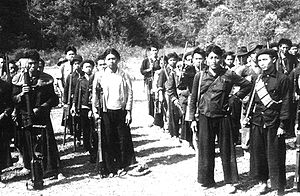
Laotian National Army strength in May 1959 peaked at 29,000 officers and enlisted men organized into twelve independent battalions – ten infantry (Bataillons d'Infanterie) and two airborne (Bataillons de Parachutistes – BP) – plus one armored regiment and an artillery group (1ér Groupe d'Artillerie). A Laotian regular infantry battalion was organized according to the French Army model into a battalion headquarters (HQ), three company HQs and three rifle companies. Long-standing major formations above battalion level, such as Regiments, Half-brigades (Demi-brigades), Brigades or even Divisions, were virtually nonexistent at the time. Instead, from
The regular units were supplemented by eighteen Regional Battalions (Bataillons Regionales), eighteen Volunteer Battalions (Bataillons de Voluntaires), and 247 irregular Commando Self-Defense village militia companies (Auto Defense de Choc – ADC). However, in November 1965 the Volunteer Battalions were disbanded and merged with the Regional Battalions,[22] whilst the rural ADC militia companies were grouped with the irregular GM B to form the CIA-sponsored Special Guerrilla Units (SGUs).[23] Renamed the Royal Lao Army in
The earlier ANL support units, such as the
Re-organization 1971–73
Following the
In 1971, with the
As stipulated by the January 1973 Paris Peace Accords, the old ethnic SGU guerrilla forces were scheduled for integration into the RLA. However, most guerrillas – in particular those from the Hmong hill tribes – felt unwelcome in the regular army, still dominated as it was by the Lowland Lao, who were highly prejudiced towards the country's ethnic minorities. In addition, the decreasing in pay and other privileges sharply dulled the cutting edge of what had been an effective fighting force, and left them incapable of halting the takeover of the country by the Pathet Lao.[27]
Final operations 1974–75
By late 1974 a thinning of RLA ranks forced the FAR High Command to replace the two ineffective strike divisions by a series of smaller, understrength brigades. These were maintained until May 1975, when the Pathet Lao entered Vientiane and dissolved the FAR.[26]
List of ANL and Royal Lao Army commanders

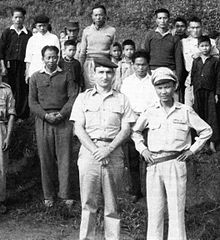
- Colonel (later, General) Sounthone Pathammavong (1954–1958)
- Major general Phoumi Nosavan (1958–1965)
- Major general Ouane Rattikone
- Major general Kouprasith Abhay (Deputy Commander-in-Chief of the Royal Lao Army, 1973–1975)
Notable field commanders
- Major general Phasouk Somly Rasaphak
- Brigadier general Soutchay Vongsavanh
- Brigadier general Thao Ty
- Major general Vang Pao
- Major general Khamta Simmanotham
- Major General Oudone Sananikone
- General Sengsouvanh Souvannarath
- General Amkha Soukhavong
- General Sing Rattanasamai
- Colonel Bounleuth Saycocie
- Colonel Saveng Vongsavath
- Captain (later, Major General) Kong Le
Elite Forces
- Royal Lao Army Airborne
- Military Region 5 Commandos (MR 5 Cdos)
- SPECOM
Weapons and equipment
Throughout its existence, the Royal Laotian Army received military assistance mainly from France and the United States, who provided since the late 1940s and mid-1950s respectively everything that the RLA used, from uniforms and boots to rifles, artillery and vehicles.
Small-arms
During the
pistols.After 1955, the ANL began the process of standardisation on U.S. equipment. Airborne units took delivery of the
ANL and RLA infantry, airborne, and commando formations were equipped with a variety of crew-served weapons.
Captured infantry weapons of Soviet and Chinese origin, such as
Armoured vehicles
By the mid-1950s, the ANL armoured corps inventory consisted of fifteen M24 Chaffee light tanks[50] whilst the reconnaissance armoured squadron was provided with twenty M8 Greyhound and M20 Armoured Utility Cars.[40] Mechanized infantry battalions were issued with M3 half-tracks and fifteen M3A1 Scout Cars.[40][51] These obsolete armored vehicles were used mainly for convoy escort duty and static defense of local provincial capitals, being rarely engaged in more offensive operations against the Pathet Lao or the NVA.[52]
The Neutralists received in December 1961 forty-five PT-76 Model 1951 amphibious light tanks from the Soviet Union, with the vehicles being subsequently taken into RLA service in 1963 and employed on offensive operations, only to be withdrawn from frontline service in November of the following year due to shortages of spare parts and ammunition. In August 1969, during the Operation About Face to recapture the Plain of Jars, the irregular Hmong SGU guerrilla forces managed to capture from the NVA some twenty-five PT-76B tanks and immediately pressed them into service, being subsequently engaged in the 1970 wet season offensive in the Plain of Jars, but once again maintenance problems soon rendered the vehicles inoperable.[48][53]
The FAR General Staff then requested the delivery of modern M41 Walker Bulldog light tanks to the RLA armoured corps in order to provide better armor support to the Hmong SGU guerrillas, but the request was declined by Washington, who provided instead in 1970-71 some second-hand fifteen M-706 armoured cars[54][55][25][56] and twenty tracked M113 armored personnel carriers.[57][58]
Artillery
Initially equipped with ten ex-French
Transport and liaison vehicles

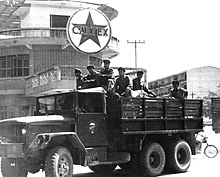
Logistics were the responsibility of the transport corps, equipped with a variety of liaison and transportation vehicles handed down by the French or supplied by the Americans. The early ANL motor pool in the mid-1950s consisted in a mixed inventory of WWII-vintage U.S.
RLA uniforms and insignia
The Royal Lao Army owed its origin and traditions to the Laotian colonial ANL and CEFEO troops on French service of the First Indochina War, and even after the United States took the role as the main foreign sponsor for the Royal Laotian Armed Forces at the beginning of the 1960s, French military influence was still perceptible in their uniforms and insignia.
Service dress uniforms
Upon its formation at the early 1950s, ANL units were initially outfitted as were French CEFEO troops of the period – the basic Laotian Army working dress for all-ranks was the French Army's M1945 tropical light khaki cotton shirt and pants (Tenue de toile kaki clair Mle 1945). Modelled after the World War II
A French-style, colonial-era white summer cotton dress uniform was initially worn by ANL officers for formal occasions, replaced in 1954 by an almost identical light khaki cotton version first adopted by senior officers serving in the ANL General Staff, and continued to be worn by their FAR successors until 1975. The new khaki dress consisted of an eight-buttoned tunic with a standing collar, provided with two breast pockets and two side pockets, all unpleated and closed by clip-cornered straight flaps, worn with matching khaki slacks. The tunic's front fly and pocket flaps were secured by gilt metal buttons bearing the FAR wreathed "Vishnu" trident.[61]
RLA Officers continued to wear the standard ANL summer service dress uniform in khaki cotton, which was patterned after the French Army M1946/56 khaki dress uniform (French: Vareuse d'officier Mle 1946/56 et Pantalon droit Mle 1946/56). The open-collar jacket had two pleated breast pockets closed by pointed flaps and two unpleated at the side closed by straight ones whilst the sleeves had false turnbacks; the front fly and pocket flaps were secured by gilt buttons. It was worn with a Khaki shirt and black tie on service dress.
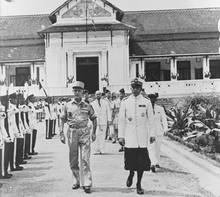
The Laotian Royal Guard (Garde Royale du Laos) were given a ceremonial dress uniform of French pattern, comprising a red kepi, white eight-buttoned cotton tunic with a standing collar and red fringed epaulettes, plus red cotton trousers with a line of gold braid down the outer side-seams.
Fatigue and field uniforms
The standard ANL field dress during the Indochina War was the French all-arms M1947 drab green fatigues (Treillis de combat Mle 1947),
By the mid-1960s, RLA units in the field were using a wide variety of uniforms depending on availability from foreign aid sources, namely the U.S., Thailand, and South Vietnam. The old French M1947 fatigues soon gave way to the US Army OG-107 jungle utilities, which was adopted as standard field dress by all the Laotian military regular and paramilitary irregular forces; M1967 Jungle Utility Uniforms also came into use in 1970-71. Local variants of the OG-107 fatigues often featured modifications to the original design – shirts with shoulder straps, two "cigarrete pockets" closed by buttoned straight flaps on both upper sleeves, or a pen pocket added on the left sleeve above the elbow, an affection common to all Laotian, South Vietnamese and Cambodian military officers, and additional side "cargo" pockets on the trousers. Olive green US M-1951 field jackets were sometimes worn by RLA and irregular SGU personnel.[66]
Camouflage was very popular among the Laotian military. Airborne formations continued to wear
Headgear
ANL officers received a service peaked cap copied after the French M1927 pattern (Casquette d'officier Mle 1927) with a lacquered black leather peak in both light khaki and white summer versions (the latter with gold embroidered flame decoration on the black cap band for general officers), to wear with the khaki service dress and the white high-collared full dress uniforms, respectively. The peaked caps were worn with the standard gilt metal ANL cap device, a wreathed Airavata crest bearing the Laotian Royal Arms – a three-headed white elephant standing on a pedestal and surmounted by a pointed parasol – set on a black cloth teardrop-shaped background patch. Upon the creation of the
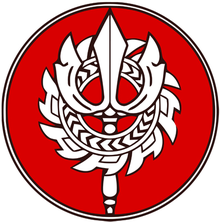
The most common headgear for the ANL personnel during the 1950s was the French M1946 "Gourka" tropical beret (Bérét de toile kaki clair Mle 1946), made of light khaki cotton cloth,[68] but later the RLA standardized on a beret pattern whose design was based on the French M1953/59 model (Bérét Mle 1953/59); it was made of wool in either one or two pieces, attached to a black leather rim with two black tightening straps at the back. In the FAR, berets were still being worn pulled to the left in typical French fashion, with the color sequence for the ground forces as follows: General Service –
. Berets made of camouflage cloth in the "Duck hunter", "Leopard", "Tigerstripe" and "Highland" patterns were also used in the field, particularly by elite units within the RLA and by the irregular SGU formations. According to the 1959 regulations, General Service and corps' berets were worn with the standard RLA beret badge placed above the right eye. Issued in gilt metal for officers and in silver metal for the rank-and-file, it consisted of a There were however exceptions to this rule, such as the Laotian airborne battalions who retained the silver winged dagger metal airborne beret badge modelled after the French pattern previously adopted in the early 1950s,[35] simply replacing the dagger by a Laotian trident after 1961.[31]Laotian troops in the field could be encountered wearing a wide range of Khaki or OG jungle hats and patrol caps, ranging from
Steel helmets, in the form of the
Footwear
White low laced leather shoes were prescribed to wear the earlier ANL white cotton full dress, whilst brown ones were worn with the khaki service/work uniform for all-ranks and, after 1954 the latter were required for RLA officers wearing the new FAR officers’ khaki dress uniform on formal occasions. ANL personnel on the field initially wore a mixture of American and French regulation footwear, including brown leather US
Army ranks
Initially, ANL troops wore the same rank insignia as their French counterparts, whose sequence followed the French Army pattern defined by the 1956 regulations[72] until 1959, when the Royal Lao Army adopted a new distinctively Laotian-designed system of military ranks, which became in September 1961 the standard rank chart for all branches of service of the newly created Royal Lao Armed Forces.
Under the new regulations, officers were entitled to wear on their service or dress uniforms stiffened red shoulder boards (pattes d'épaule) edged with gold braid and a gold wreathed trident at the inner end. Junior officers (Officiers subalternes) added an appropriate number of five-pointed gold stars to their boards whilst field grade officers (Officiers supérieures) had a single lotus leaf rosette, plus an appropriate number of five-pointed gold stars. Field Marshals and General officers (Marechaux et Officiers Géneraux) had a gold leaf design around the lower half of their shoulder boards plus two or more five-pointed silver stars. Senior and junior NCOs (Sous-officiers) – including Private 1st class – wore cloth chevrons on both upper sleeves; enlisted men (Hommes de troupe) wore no insignia.
In the field, officers' shoulder boards were initially replaced by metal rank insignia pinned to simple rectangular red cloth tabs sewn over the right shirt or combat jacket pocket,[67] but some senior officers kept the custom of wearing instead a single chest tab (patte de poitrine) buttoned or pinned to the shirt's front fly following French Army practice.[73] By the late 1960s, an American-style system was adopted in which metal pin-on or embroidered cloth rank insignia – either in yellow-on-green full-colour or black-on-green subdued form – were worn on the right collar, though photographic evidence shows that officers on the field also had the habit of displaying their rank insignia on berets, baseball caps, bush hats and (more rarely) on steel helmets.[74]
Rank insignia

|

|

|

|

|

|

|

|

|

|

| ||||||||||||||
| Field marshal Choum Phoun |
General Phoun Êek |
Lieutenant general Phoun Thö |
Major general Phoun Trïï |
Brigadier general Phoun Chatäävä |
Colonel Phan Êek |
Lieutenant Colonel Phan Thö |
Major Phan Trïï |
Captain Loei Êek |
1st lieutenant Loei Thö |
2nd lieutenant Loei Trïï | ||||||||||||||
| No insignia | ||||||||||||||||||||||||||||||
| Sergeant major Cãã Êek |
Master sergeant Cãã Thó |
Sergeant 1st class Cãã Trii |
Staff sergeant Sip Êek |
Sergeant Sip Thó |
Corporal Sip Trii |
Private 1st class Sip |
Private Sip | |||||||||||||||||||||||
Branch insignia
RLA skill and trade badges also came in gilt metal and/or enamelled pin-on and cloth embroidered yellow or black-on-green subdued variants. On dress and service uniforms, they were worn on both collars by all-ranks if shoulder boards were worn, but in the field officers wore them on the left shirt collar only if worn alongside collar rank insignia; enlisted ranks usually wore branch insignia on both collars instead.[74]
Unit insignia
Yellow and subdued nametapes were occasionally worn above the right shirt or jacket pocket on field dress; plastic nameplates were worn with the service and dress uniforms. Elite formations such as the Special Commando Company of the 2nd RLA Strike Division had their unit designation printed over their left pocket.
See also
- 1967 Opium War
- Army of the Republic of Vietnam (ARVN)
- Air America
- Battle of Lang Vei
- Directorate of National Coordination
- Hmong people
- North Vietnamese invasion of Laos
- Pathet Lao
- Khmer National Armed Forces
- Lao Veterans of America
- Lao Veterans of America Institute
- Laos Memorial
- Laotian Civil War
- Royal Lao Air Force
- Royal Lao Army Airborne
- Royal Lao Police
- Vietnam War
- Weapons of the Laotian Civil War
Notes
- .
- ^ Conboy and Greer, War in Laos, 1954-1975 (1994), p. 5.
- ^ Conboy & Morrison, Shadow War: The CIA's Secret War in Laos (1995), p. 2.
- ^ "History of Laos - the official website for Visit Laos Years 1999-2000". Archived from the original on 2008-07-05. Retrieved 2008-07-05.
- ISBN 978-0-8248-7512-1.
- ^ Laos, 1948-1989; Part 1: A Failed Experiment – http://www.acig.org/artman/publish/article_347.shtml
- ^ Bodin, Michel (March 2019). "Naissance et développement des armées nationales cambodgienne et laotienne, 1946-1950" (PDF). Soldats de France (in French). No. 12.
- ^ Conboy and Greer, War in Laos (1994), pp. 4-5.
- ^ Conboy & Morrison, Shadow War: The CIA's Secret War in Laos (1995), p. 4.
- ^ Conboy & Morrison, Shadow War: The CIA's Secret War in Laos (1995), pp. 3-4.
- ^ http://lcweb2.loc.gov/cgi-bin/query2/r?frd/cstdy:@field(DOCID+la0030)
- ^ Bodin, Michel (March 2019). "Naissance et développement des armées nationales cambodgienne et laotienne, 1946-1950" (PDF). Soldats de France (in French). No. 12.
- ^ Conboy and Greer, War in Laos 1954-1975 (1994), pp. 5-7; 13.
- ^ Conboy and McCouaig, The War in Laos 1960-75 (1989), p. 4.
- ^ Conboy and McCouaig, The War in Laos 1960-75 (1989), pp. 24; 33.
- ^ Castle, At War in the Shadow of Vietnam (1993), pp. 9-12; 15-19.
- ^ Ahern, Undercover Armies: CIA and Surrogate Warfare in Laos (2006), pp. 52; 55.
- ^ Anthony and Sexton, The War in Northern Laos (1993), p. 12.
- ^ a b Conboy and McCouaig, The War in Laos 1960-75 (1989), p. 12.
- ^ Conboy and Greer, War in Laos 1954–1975 (1994), p. 14.
- ^ Conboy and McCouaig, South-East Asian Special Forces (1991), p. 18.
- ^ Conboy and McCouaig, The War in Laos 1960-75 (1989), pp. 12-13.
- ^ Conboy and Morrison, Shadow War: The CIA's Secret War in Laos (1995), pp. 97–99.
- ^ Sananikone, The Royal Lao Army and U.S. Army advice and support (1981), pp. 169-173.
- ^ a b Grandolini, Armor of the Vietnam War (2): Asian Forces (1998), p. 13.
- ^ a b c Conboy and McCouaig, The War in Laos 1960-75 (1989), p. 13.
- ^ a b Conboy and McCouaig, The War in Laos 1960-75 (1989), p. 19.
- ^ Sananikone, The Royal Lao Army and U.S. Army advice and support (1981), p. 30.
- ^ Conboy and Morrison, Shadow War: The CIA's Secret War in Laos (1995), pp. 3-4.
- ^ "Post-WWII use of the MAS-36 rifle: Part II (export users)". wwiiafterwwii.wordpress.com. 2015-08-23. Archived from the original on April 5, 2023. Retrieved 2017-06-15.
- ^ a b Conboy and McCouaig, The War in Laos 1960-75 (1989), p. 15.
- ^ a b Conboy and McCouaig, The War in Laos 1960-75 (1989), p. 38.
- Bonn International Center for Conversion; Bundeswehr Verification Center. "Sten MP". SALW Guide: Global distribution and visual identification.
- ^ Conboy and McCouaig, The War in Laos 1960-75 (1989), p. 36.
- ^ a b c Conboy and McCouaig, South-East Asian Special Forces (1991), p. 8.
- ^ a b c Conboy and Greer, War in Laos 1954–1975 (1994), p. 12.
- ^ Walter, Walther Pistols – PP, PPK and P 38 (2022), pp. 68-70.
- ^ a b Conboy and Greer, War in Laos 1954–1975 (1994), p. 9.
- ^ Thompson, The M1 Carbine (2011), p. 67.
- ^ a b c Conboy and Greer, War in Laos 1954–1975 (1994), p. 18.
- ^ Conboy and McCouaig, The War in Laos 1960-75 (1989), p. 46.
- ^ a b c Conboy and Greer, War in Laos 1954–1975 (1994), p. 59.
- ^ Conboy and McCouaig, The War in Laos 1960-75 (1989), pp. 15-21.
- ^ Conboy and Greer, War in Laos 1954–1975 (1994), p. 39.
- ^ Conboy and McCouaig, The War in Laos 1960-75 (1989), p. 43.
- ^ Conboy and Greer, War in Laos 1954–1975 (1994), pp. 10; 18.
- ^ Rottman, The AK-47 Kalashnikov-series assault rifles (2011), p. 78.
- ^ a b Conboy and Greer, War in Laos 1954–1975 (1994), p. 34.
- ^ Conboy and McCouaig, The War in Laos 1960-75 (1989), pp. 41-42.
- ^ Zaloga and Laurier, M24 Chaffee Light Tank 1943–85 (2003), p. 22.
- ^ Grandolini, Armor of the Vietnam War (2): Asian Forces (1998), p. 12.
- ^ Grandolini, Armor of the Vietnam War (2): Asian Forces (1998), p. 20.
- ^ Grandolini, Armor of the Vietnam War (2): Asian Forces (1998), pp. 13; 27.
- ^ Conboy and Greer, War in Laos 1954–1975 (1994), pp. 40; 63.
- ^ Conboy and Morrison, Shadow War: The CIA's Secret War in Laos (1995), p. 290.
- ^ Lathrop, McDonald and Laurier, Cadillac Cage V-100 Commando 1960-71 (2002), p. 38.
- ^ Christopher F. Foss, Jane's Tank & Combat Vehicle recognition guide (2002), p. 215.
- ^ a b SIPRI Arms Transfers Database
- ^ a b c "Annex C Appendix II". US Army Technical Manual of Foreign Military Sales: Battlefield Damage Assessment and Repair (PDF). Washington, D.C. 18 December 1987. p. 262. TM 9-2320-356-BD. Archived (PDF) from the original on 4 September 2012. Retrieved 15 June 2013.
{{cite book}}: CS1 maint: location missing publisher (link) - ^ Conboy and Greer, War in Laos 1954–1975 (1994), pp. 63-64.
- ^ a b c Conboy and McCouaig, The War in Laos 1960-75 (1989), p. 40, Plate B3.
- ^ a b Conboy and Greer, War in Laos 1954–1975 (1994), p. 6.
- ^ Conboy and McCouaig, South-East Asian Special Forces (1991), p. 6.
- ^ Conboy and Greer, War in Laos 1954–1975 (1994), p. 7.
- ^ Conboy and McCouaig, South-East Asian Special Forces (1991), pp. 7-8.
- ^ Conboy and McCouaig, The War in Laos 1960-75 (1989), p. 44.
- ^ a b Conboy and McCouaig, The War in Laos 1960-75 (1989), p. 3.
- ^ Dutrône and Roques, L'Escadron Parachutiste de la Garde Sud-Vietnam, 1947-1951 (2001), p. 14, photo caption 1.
- ^ "The Secret War in Laos - About Laos". Archived from the original on October 16, 2021.
- ^ Conboy, FANK: A History of the Cambodian Armed Forces, 1970-1975 (2011), p. 278.
- ^ Conboy and McCouaig, South-East Asian Special Forces (1991), p. 7.
- ^ Gaujac, Officiers et soldats de l'armée française d'après le TTA 148 (1943-1956) (2011), pp. 38-45.
- ^ Lassus, Les marques de grade de l'armée française, 1945-1990 (1er partie-introduction) (1998), pp. 12-15.
- ^ a b Conboy and McCouaig, The War in Laos 1960-75 (1989), p. 14.
References
- Andrea Matles Savada (ed.), Laos: a country study (3rd ed.), Federal Research Division, Library of Congress, Washington, D.C. 1995.
- Albert Grandolini, Armor of the Vietnam War (2): Asian Forces, Concord Publications, Hong Kong 1998. ISBN 978-962-361-622-5
- Bernard Fall, Anatomy of a Crisis: The Laotian Crisis of 1960–1961, Doubleday & Co., 1969. ASIN B00JKPAJI4
- Brig. Gen. Soutchay Vongsavanh, RLG Military Operations and Activities in the Laotian Panhandle, United States Army Center of Military History, Washington D.C. 1980.
- Gordon L. Rottman, The AK-47 Kalashnikov-series assault rifles, Weapon series 8, Osprey Publishing Ltd, Oxford 2011. ISBN 978-1-84908-461-1
- John Walter, Walther Pistols – PP, PPK and P 38, Weapon series 82, Osprey Publishing Ltd, Oxford 2022. ISBN 9781472850843
- Joseph D. Celeski, Special Air Warfare and the Secret War in Laos: Air Commandos 1964–1975, Air University Press, Maxwell AFB, Alabama 2019. – [2]
- Kenneth Conboy and Don Greer, War in Laos 1954-1975, Squadron/Signal Publications, Inc., Carrollton, Texas 1994. ISBN 0-89747-315-9
- Kenneth Conboy and Simon McCouaig, The War in Laos 1960-75, Men-at-arms series 217, Osprey Publishing Ltd, London 1989. ISBN 978-0-85045-938-8
- Kenneth Conboy and Simon McCouaig, South-East Asian Special Forces, Elite series 33, Osprey Publishing Ltd, London 1991. ISBN 1-85532-106-8
- Kenneth Conboy with James Morrison, Shadow War: The CIA's Secret War in Laos, Boulder CO: Paladin Press, 1995. ISBN 978-1581605358, 1581605358
- Khambang Sibounheuang (edited by Edward Y. Hall), White Dragon Two: A Royal Laotian Commando's Escape from Laos, Spartanburg, SC: Honoribus Press, 2002. ISBN 978-1-885354-14-3
- Leroy Thompson, The M1 Carbine, Weapon series 13, Osprey Publishing Ltd, Oxford 2011. ISBN 9781849086196
- Maj. Gen. Oudone Sananikone, The Royal Lao Army and U.S. Army advice and support, Indochina monographs series, United States Army Center of Military History, Washington D.C. 1981. – [3]
- Nina S. Adams and Alfred W. McCoy (eds.), Laos: War and Revolution, Harper & Row, New York 1970. ASIN B0015193EW
- Roger Warner, Shooting at the Moon: The Story of America's Clandestine War in Laos, South Royalton, VT: Steerforth Press, 1998. ISBN 978-1883642365
- Richard Lathrop, John McDonald and Jim Laurier, Cadillac Cage V-100 Commando 1960-71, New Vanguard series 52, Osprey Publishing Ltd, Oxford 2002. ISBN 1 84176 415 9
- Thomas Ahern, Undercover Armies: CIA and Surrogate Warfare in Laos, Center for the Study of Intelligence, Washington D.C. 2006. Classified control no. C05303949.
- Timothy Castle, At War in the Shadow of Vietnam: United States Military Aid to the Royal Lao Government, 1955–1975, Columbia University Press, 1993. ISBN 978-0-231-07977-8
- Victor B. Anthony and Richard R. Sexton, The War in Northern Laos, Command for Air Force History, 1993. OCLC 232549943
- Steven J. Zaloga and Jim Laurier, M24 Chaffee Light Tank 1943–85, New Vanguard series 77, Osprey Publishing Ltd, Oxford 2003. ISBN 9781841765402
Secondary sources
- Arnold Issacs, Gordon Hardy, MacAlister Brown, et al., Pawns of War: Cambodia and Laos, Boston Publishing Company, Boston 1987. ISBN 9780201116786, 0-201-11678-2
- Christophe Dutrône and Michel Roques, L'Escadron Parachutiste de la Garde Sud-Vietnam, 1947-1951, in Militaria Magazine No. 188, March 2001, Histoire & Collections, Paris. )
- Christopher Robbins, Air America, Weidenfeld & Nicolson, 2012. ASIN B007TNY0GQ
- Christopher F. Foss, Jane's Tank & Combat Vehicle recognition guide, HarperCollins Publishers, London 2002. ISBN 0-00-712759-6
- Denis Lassus, Les marques de grade de l'armée française, 1945-1990 (1er partie-introduction), in Militaria Magazine No. 159, October 1998, Histoire & Collections, Paris. )
- Denis Lassus, Les marques de grade de l'armée française, 1945-1990 (2e partie-les differents types de galons), in Militaria Magazine No. 161, December 1998, Histoire & Collections, Paris. )
- Kenneth Conboy, Kenneth Bowra, and Simon McCouaig, The NVA and Viet Cong, Elite series 38, Osprey Publishing Ltd, Oxford 1992. ISBN 978-1-85532-162-5
- Kenneth Conboy, FANK: A History of the Cambodian Armed Forces, 1970-1975, Equinox Publishing (Asia) Pte Ltd, Djakarta 2011. ISBN 9789793780863
- Military History Institute of Vietnam, Victory in Vietnam: The Official History of the People's Army of Vietnam, 1954–1975 (translated by Merle Pribbenow), Lawrence KS: University of Kansas Press, 2002. ISBN 9780700611751, 0-7006-1175-4
- Paul Gaujac, Officiers et soldats de l'armée française d'après le TTA 148 (1943-1956), Histoire & Collections, Paris 2011. ISBN 978-2352501954 (in French)
